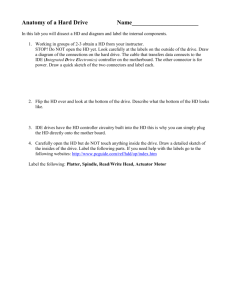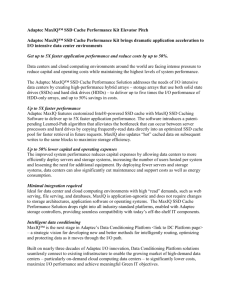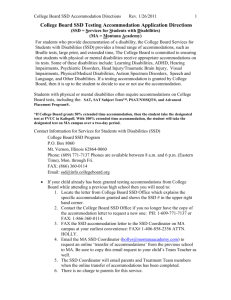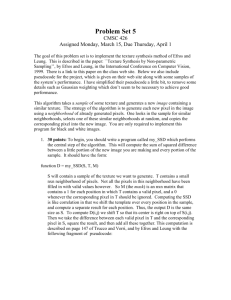Dr Azizian SSD ASIA DCAF2012
advertisement
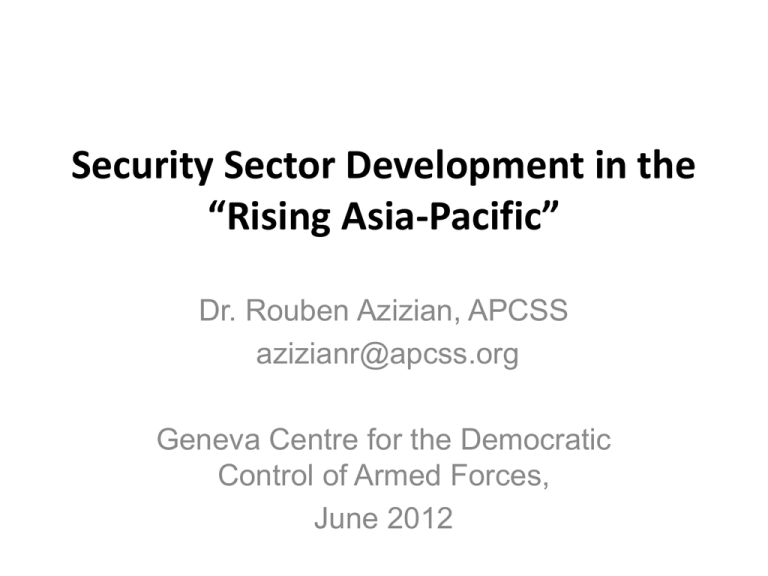
Security Sector Development in the “Rising Asia-Pacific” Dr. Rouben Azizian, APCSS azizianr@apcss.org Geneva Centre for the Democratic Control of Armed Forces, June 2012 Presentation Outline • Realism and triumphalism about the rise of Asia • Implications for the security sector management and development • Key regional features and debates on security sector development • SSD in security studies: APCSS experience and perspective • Recommendations Realism or Triumphalism? • Kishore Mahbubani: “ Asia returns to the center stage in global politics and economics… Western domination of world history has been a major historical aberration. “ The New Asian Hemisphere, 2011 A Map of Asia-Pacific Characteristics of the Rise of Asia • Asia-wide rise (China but also India, Indonesia, Vietnam and others) • Comprehensive rise (economic, military, diplomatic) • Demands of enhanced world economic and political role • Increased role in shaping international and regional institutions (BRICS, EAS) • US and Russia’s reorientation to Asia • Central Asia’s asianization • Alternative model of development (Europe’s crisis and US politics) Asia’s Challenges and Problems • • • • • • • • • 2/3 of world’s poor are in Asia Extremism, terrorism and separatism Handling transition from extensive to intensive growth Major energy, ecological and demographic insecurity Asia’s “Great Game” and rivalry Territorial disputes (South China Sea, etc.) Questions about US commitment Competing regionalism (ASEAN and major powers) Vulnerability of authoritarian models (Myanmar, Fiji) Implications for security sector development • Diversity of the region leads to diverse SSD perspectives and approaches • Economic growth reduces reliance on external donors • Economic success promotes Asian models of governance • Military modernization enhances role of the military • Increased political maturity leads to a more strategic perspective on SSD • Enhanced regionalism opens new opportunities for sharing SSD experiences Asia-Pacific: Security Sector Challenges • No overarching security policies • Weak or outdated legal framework Policies & Framework • Weak & overlapping mandates Personnel Capacity • Executive dominance • Limited capacity among parliamentarians • Underrepresented or dysfunctional coordination mechanisms • Internal capacity constraints within line ministries responsible for Institutional formulation & management of security policy Capacity 8 SSD Debates in the Asia-Pacific • Definition of security sector given the comprehensive nature of security • Typology of security and assignment of responsibilities (external/internal/transnational) • Type of democratic governance most conducive for SSD (presidential, parliamentary) • Sequencing security strategy, policy and legislation • Ambiguity of the “civil-military relations” concept • Democratization vs. politicization of security forces • Pragmatist views and cultural norms in SSD Regional Cooperation on SSD Constraints Positive Trends • Diversity of national contexts and security sector priorities • Lack of regional information and best practices sharing on SSD • Constraints of regional organizations - Security Sector Governance project in the Pacific, Pacific Islands Forum, 2009 - UN’s contribution to SSD in the region 10 SSD at APCSS • • • • • APCSS Mission Fellows and alumni Evolution of courses and programs “Rise” of SSD in APCSS priorities APCSS activities on SSD: workshops, electives, research • Opportunities ahead Recommendations • Refine SSD goals and objectives for the AsiaPacific • Promote and support SSD studies in the region • Establish regular dialogue and cooperation between DCAF and APCSS - invite to workshops and conferences - joint research and publications

